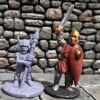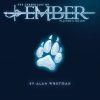Fringe Review: Bloodshadows: Fantasy-Noir Roleplaying from ZDL's blog
Full disclosure: I was given this game for free by its publisher. This was not done for purposes of review (more out of pity!), but it would not be honest to fail to mention this potential bias.
I have a somewhat complicated relationship with Bloodshadows. I originally encountered it when it was a West End Games setting for their Masterbook game (itself part of the '90s trend of turning every house game system—in this case the game system behind Torg and Shatterzone—into a generic game). The thing is that while I admired several features of Masterbook, at it core I found it a pretty fundamentally flawed game that I didn't want to play very much. Which was a pity because the Bloodshadows setting I adored straight out of the box.
So here we are, over two decades later, and I find myself with a Bloodshadows game in my hand from the home where all the great, undervalued games go for continued unlife: Precis Intermedia (rapidly becoming my favourite currently-active publisher of RPGs).
History
First published as a setting book for Masterbook (as mentioned above) in 1994, Bloodshadows was an intriguing blend of setting elements whose actual genre was hard to pin down beyond "horror/fantasy/pulp/noir". It was the first world in the line, and the only one based on an property original to Masterbook rather than being licenced. (The other properties were properties such as Indiana Jones, Necroscope, Species, Tank Girl, etc. etc. etc., many of which didn't get a lot of support beyond their one world book and were of very dubious benefit.)
Masterbook as a system was not, however, very popular when compared to WEG's other major system: their D6 system derived from the first (and still best!) Star Wars RPG (itself derived from the Ghostbusters RPG). D6 was a beast of a system, economically speaking, and it made sense at the time to rewrite Bloodshadows for that system. Unfortunately this roughly coincided with the shoe selling difficulties that killed WEG, leading Bloodshadows out in the cold, systemwise. 2004 was the end of Bloodshadows … or so it seemed.
Precis Intermedia, however, had other ideas. They acquired the rights to the game and setting (as well as to Masterbook) and published an interim release while they patiently reworked the rules into their in-house Genre Diversion 3rd Edition rules system. Thus, in 2016, 22 years after Masterbook landed with its first setting, Bloodshadows: Fantasy-Noir Roleplaying was released. It is this edition, specifically its PDF edition, which I will be reviewing.
The Basics
Bloodshadows is a beefy 259 page PDF. Its striking cover lets you know from the start what you're in for, with the '40s-era garb, the very noirish detective and his two female companions, the guns, the magic spell showing in one of the companions' hand, and the ghostly shadows haunting the edges of the picture set in a dark, moody hall. Of interest in this third edition is that the cover is far more equitable. Two of the characters in it (the square-jawed detective and the vamp in a slinky black dress) have been in all of the game's editions' covers, but in this one the vamp has a gun out and is an active participant in the scene being played out whereas earlier editions had her helplessly clinging to the hero while the hero bravely stood off evil. (Bleah!) The addition of the non-vamp "Girl Friday" spell caster further adds to the appeal of the cover to me. Mr. Bernstein has a good eye for keeping up with the times, I feel.
Internal art consists of moody black-and-white full-page pictures at the head of each chapter—several of them riffing in interesting ways on classic works like the most-parodied painting of all time: the diner scene—which tend to vary between "competent" and "stunning" while little inline illustrations here and there are black and white line drawings ranging in calibre from "meh" to "pretty decent". None of the art comes across as randomly selected filler. Even when what's in the picture doesn't illustrate what's in the text around it, it does quite a good job of setting the mood. The art director deserved whatever money he got. And likely more, given the state of game publishing.
Internally the rules are competently typeset and laid out. There is a background, and the background, faint as it is, could prove distracting to people, especially those who have vision problems, but thankfully there is, on the landing page, a big button to press that can turn off the background for those who just want the text and pictures. The fonts of section headings are … well, honestly I'm not a huge fan. I can see they were selected for their feel, but I find them a bit ugly. Thankfully the important fonts (actual body text) are nicely readable serif fonts.
The book opens with the once-inevitable fiction piece that was used to establish genre and tone in so many books. Usually I hate these: the writing is most commonly amateurish and it whiffs of page count filling. I don't hate this one. I don't like it much, but it doesn't feel wasteful. The game setting and genre is just weird enough that this fiction, as lacklustre as it may be, does a good job of illustrating some of the key concepts and moods of the game. In succession after this is a chapter on the world, a chapter on character generation, on basic rules, combat rules, equipment, magic, GMing (known in this game as "directing"), "unnaturals" (the monsters of the setting…many of which are also available as PCs), one of the major cities of the setting, and some adventures (called "stories"). An appendix rounds out the book with sample characters, reference sheets, and character sheet blanks. (Of course there's tasteful advertisement for Precis Media's other products as well.)
Of course the publication is not perfect. (Very few are.) The whopping huge missing element here, however, is the index. There isn't one. This could be considered laudable in that a bad index is just a waste of pages, but I'd much rather have seen a good index. Tragically, good indexing is hard work and game publishers usually lack the margins required to spend the money to get good indexing done.
The System
The name of the game system is formally "Genre Diversion 3rd Edition" which is one iteration past the "Genre Diversion i" rules set previously published by Precis Intermedia (if I have that ordering right). It appears, too, that the goal of the design was to make the game at least roughly compatible with Precis Intermedia's Active Exploits diceless game; there's a page on using AE with Bloodshadows that is so trivial it almost (but not quite) doesn't need to be in the book.
Characters
Characters in the game are defined by five "abilities", ranked 0-5: Fitness, Awareness, Creativity, Reasoning, and Influence. 0 is considered a disability, 2-3 is average, anything over 5 is "unimaginable" (and not available to normal human beings). A sidebar notes that the perceived paucity of abilities is a vestige of the deeply-entrenched war game roots of RPGs, but that mechanisms like "ability gimmicks" can be used to replicate that for those who wish that level of detail while keeping the game smooth and simple
In addition, characters are defined by "pursuits" (what other games might call "skills"), rated from -1 to +4 with 0 being "basic knowledge" and +4 being "grand-mastery". All characters have basic knowledge (0) in all pursuits that are not flagged as "academic pursuits". Those default to "incompetent" (-1). Pursuits are generally paired with specific abilities, but, for example, firing a gun from the hip, usually a "fitness" task, could be based on "awareness" instead while "reasoning" could be used to time a punch in a way that slips past defences. This is a refreshingly improvisational approach that I've always enjoyed in games that permitted it.
Gimmicks are the next piece of character definition and these are aspects of characters defined by background, physical oddities, personality, and other traits not covered by abilities and pursuits. Physical gimmicks might be things like "appearance" which gives a bonus (or penalty!) to influence in matters involving pure attractiveness. Cultural gimmicks could be something like "authority (police)" that provide special social powers over and above those of a normal citizen. Special gimmicks could be something like "aversion(holy water)" (not all gimmicks are good, recall).
Alignment is a thing in Bloodshadows, but it is a thing closely tied to the setting so it will be discussed in that part of the review. Also a thing in the game is species (refreshingly called that accurate term for a change instead of the cringe-worthy "race"). There are a lot of species. Just the general classifications of them are: pure races (of which only humans are commonly known), breeds, demons, shifters, undead, and wilderness creatures (these latter not available as PCs). Sixteen player species are provided and several more wilderness creatures are detailed in the GM's section.
Every character also has a role, something like a character class (or, for those familiar, more like a D6 template). Ten roles are provided, plus an eleventh that can be used as the basis for characters which don't fit the other categories. Each role (like "spellslinger") is given a set of required pursuits, recommended pursuits, mandatory gimmicks, and free equipment.
To the designer's credit (Brett M. Bernstein), the creation of a character is simple process. I'd only have one small suggestion to make for future reference: put the character generation reference sheet at the beginning of the chapter and then order the information in the same sequence as people are going to use it. There was a lot of reading here without a framework to hang it off of until, well, it had all been read. Making a character is simple, but it didn't feel that way at first.
Basic rules
The core game mechanism of Bloodshadows is a simple task roll system modified by circumstance to suit. In time-critical scenes (like combat) a "turn" involving one die roll is roughly five seconds long, but in more abstract circumstances, a die roll could represent other measures. One ability is used in conjunction with one pursuit (c.f. above for these). The ability is usually, but not always, the primary ability of the pursuit but can be altered by circumstance. The example the text gives is that firing a gun is Fitness, but repairing it could be Reasoning-based instead, using the Firearms pursuit in both cases. Degrees of difficulty range from "Trivial" through "Impossible" with target numbers attached. A "routine" task is 10 difficulty, for example, while a "challenging" one is 14. Situational modifiers tend to modify the difficulty. Tasks are rolled with 2d6 summed, adding the governing ability and pursuit, and if this equals or exceeds the target number from difficulty the task succeeds. "Overkill" is the difference between the roll and the target and can be positive (success) or negative (failure). This overkill number is used in some systems, most notably contested tasks and exploits. Double-6 and double-1 are triumphs and calamities respectively and act like critical successes and failures.
The game system offers various modifications like over-exertion, exchanging fatigue/tension for success, automatic tasks for eliminating unnecessary rolls, contested tasks for when to opponents directly apply skills against each other, passive tasks for unconscious or reflexive applications of ability, united tasks for joint action, investigation tasks, composure tasks, reaction tasks, connection tasks, … well, the list goes on. Each takes the basic mechanism and is more a guideline on how to interpret results and what difficulty modifiers might exist rather than new rules.
Exploits, however, are of interest, in that if a task results in 5 or more overkills, special effects can come into play. Characters can choose from a variety of effects based on what kind of task they were performing, like reducing difficulty of tasks for allies, completing tasks more quickly, etc.
Experience, like many games of the original Bloodshadow's era, is a combination of a character growth mechanism and a "fate point"-style mechanism that can be used to assist in-game actions.
Combat
Combat, as mentioned before, is done in turns of approximately five seconds. Movement is measured in "spaces" which are pretty abstract and can be viewed as two yards or metres (since they're roughly equivalent) at need. In general characters can do one task per turn, though attempting multiple tasks is possible at a stiff, increasing penalty. Only one task roll is made, however, no matter how many tasks are attempted, if the tasks are the same action on different targets. That little quirk aside, the combat system is pretty standard for a game of the original publication's era: attention is paid in moderate detail to movement, positioning, ranges, and environment. It's not at wargame levels of detail, but it certainly is also not a so-called "story game". As mentioned before, the core mechanism never really changes. It only gets its application clarified. It looks like a lot of rules, but it's pretty much common sense application of a single core idea.
One thing the game gets definitely right is putting social combat on the same footing as physical. This is far more satisfying than the more typical approach of having detailed, wargaming rules for physical conflict but hand-waving single-roll rules for complex social situations.
The damage system is pretty interesting, and, notably, covers not just physical damage but psychosocial and simple madness. Character health is marked by "marks", "lines", and "grades" of damage in the form of "fatigue", "injury", "tension" and "mania". Marks are checkboxes, arranged into lines of different lengths based on abilities. When a line is marked off, the damage effects move up a grade. So damage is taken by marks which, each time a line is filled off, increases the impact of damage by a grade. When damage is taken, too, it may be abated by appropriate protection (padding, armour, will, ego respectively). For each mark, a die is rolled, and if that die is less than or equal to the protective value, it's considered to have not pierced the protection. So, for example, if 3 marks of injury damage was caused to a character wearing bones/hide armour (protection 1) and 3d6 rolled 2 1 5, only two points would penetrate, the 1 result being absorbed by the armour. Not all damage can be abated, it should be noted: some is "absolute" and is just directly applied.
Magic
Ah yes, magic. The game's setting, Marl, is high-magic, and in it magic and spells are on the same order of expectation as we expect electricity. Everybody knows a little magic. Magic is arranged in nine "schools" (chronomancy, elementalism, necromancy, photomancy, somniomancy, sorcery, technomancy, vitomancy, and wizardry). Casting spells is a straightforward application of tasks, only the casting pursuit is combined with an ability determined by a theory (alteration, apportation, conjuration, divination, and invocation) pursuit that was used to create the spell. Difficulty ratings are by spell, and effects involve ranges and durations and other such usual affairs. United tasks can be used to form rituals, and there may be special requirements in spells like special components or gestures or such. Spells can cause feedback on failure which can have bad effects on characters.
A wide variety of "established" spells are provided and a full system for creating new spells is presented in eight pages of fairly dense rules requiring a worksheet to get through. In truth the magic system is the most complicated part of Bloodshadows, though against the standards of games like Chivalry & Sorcery (1st or 2nd edition) it's not that bad. It is most definitely not "rules-light" however.
The Setting
Which brings us, now that we know how characters are defined and how they interact, to the setting: the world of Marl (and specifically the continent of Eln). Marl is a high-magic world full of monsters that has survived a "Godwar" between the cults of the gods of Order and of the gods of Chaos. Civil wars flooded through empires in a fight for minds and souls and in the aftermath of the death spasms of empires the Others came, with humans now fighting against (and alongside) horrors like the undead or shapeshifters or their ilk. Civilization fell back to fortified towns and cities and the wilderness was left to the kind of unnatural ilk that made the unnaturals that lived together with humans now look positively normal. The heart of the setting is now its cities and the lands in their immediate vicinity feeding them. Cities are tenuously linked by couriers and even more tenuously by trade. Teleportation and telepathy are used to travel and communicate with overland travel almost unheard of over any distance.
And the Godwar is coming back, this time fighting in the board rooms and the alleys, not in battlefields. Alignment, as mentioned before, is a thing, in that characters can be affiliated with the sides of the Godwar (Order or Chaos) if they choose, or they can instead be a part of so-called Oathbreakers, factions which have abandoned one side or the other and which live in uneasy alliance against them. (Or, naturally, characters can be unaligned.) The second Godwar is intended to drive some of the action in a campaign but designed in a way as to be background colour or front-and-centre in an individual GM's game.
The horror notes of Marl are obvious, given the denizens of the world, as are the noir notes, given the cynical, hardbitten nature of the setting. Less obvious, but present, are the more straightforward urban fantasy notes and, concealed within the game's very mechanics, the adventure pulp notes, though more in the direction of detective pulps than pulp sci-fi.
Goethe's Ghost
This is the part where I answer Goethe's three famous questions:
1. What was the designer trying to accomplish?
2. Did the designer accomplish it?
3. Was it worth accomplishing?
What the original designer of Bloodshadows was trying to accomplish was to create a compelling setting for Masterbook. What the current designer of the 3rd edition was trying to accomplish was to make a game that had the feeling of the original while being more modular, compatible with other games in the ever-expanding Precis Intermedia lineup, and being substantially simpler. As far as I'm concerned both succeeded at their respective tasks.
Bloodshadows has always been a setting that intrigued me, but Masterbook as a game, especially with the original Bloodshadows world book, was too deeply flawed for me to ever turn that intrigue into actual play. (I find that Masterbook is a game of ludicrous extremes like a campy sci-fi serial … while being like a wargame in the sheer variety and volume of rules.) With this new third edition, I am actively looking for people to try it out. The rules are now manageable for my poor, simple little brain (and compatible with Active Exploits at very little effort, for my diceless needs in online chat settings).
So was the work worth it?
I'll put this at a "yes" but with some qualifications. Before I encountered FATE or other such games my "yes" would be completely unqualified. Now, though, although I am actively seeking players of the game, in the back of my mind I'm also thinking that it would be pretty easy to take the interesting concepts and setting of Bloodshadows and simply play it with FATE. Personally I like this game and would like it even if I had had to pay for it. I could see, however, an argument for using it mostly as source for a more story-oriented game.
That being said, Precis Intermedia sells this at a nice price point, so even if all you want is the setting, the game is certainly more than worth a purchase.
















The Wall